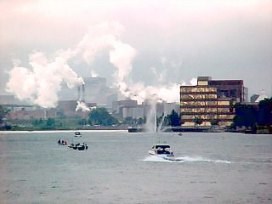Just days after Liberal Leader Dalton McGuinty noted that the Sault had experienced its "first smog day ever," Environment Ontario is reporting that we currently have the worst air quality in the province.
The Environment Ministry reports our most recent Air Quality Index (AQI) reading as 46, with a caution that people with respiratory disease may be at some risk.
No other Ontario community is in the 40s.
These cities have AQI readings in the 30s:
- Barrie, 39 - Hamilton Mountain, 38 - Hamilton Downtown, 37 - North Bay, 37 - Guelph, 35 - Toronto West, 35 - Brampton, 34 - Kitchener, 34 - Oshawa, 34 - York Region, 34 - Toronto North, 34 - Peterborough, 33 - Toronto East, 32
On Wednesday, Liberal Leader Dalton McGuinty told the Ontario Legislature that Saultites "came of age" on Tuesday, when he said we experienced our "first smog day ever."
Our reading that day was 46, the same as the most recent reading.
To read the full text of McGuinty's remarks and a response from Premier Ernie Eves, please click here. Cleanest air is in Sudbury, Thunder Bay
The best air quality in the province is reported in Sudbury (10), Thunder Bay (10), Kingston (11) and Ottawa (12).
The Environment Ministry monitors air quality in 30 communities across the province.
The most recent AQI numbers were recorded at 5 p.m. yesterday.
The ministry tests for six key pollutants: sulphur dioxide, ozone, nitrogen dioxide, total reduced sulphur compounds, carbon monoxide, fine particulate matter.
It's the latter pollutant that's being blamed for the most recent reading.
What the numbers mean
On the AQI index, the Sault's reading of 46 is at the upper extreme of the moderate range, which runs from 32 to 49. That means there could be adverse effects on very sensitive people.
A reading in the poor range (50-99) could have short-term adverse effects on humans or animals, or cause significant damage to vegetation and property.
Environment Ministry records show that on Sept. 9, Sault Ste. Marie experienced a 90 reading, the highest for the current smog season. That reading was also attributed to fine particulate matter.
Is your regular news source reporting this story?
If you appreciate SooToday's independent, in-depth treatment of local news, why not make us your home page? It's easy. Just click here.
Editor's note: the photo at the top of this page is from our files, and is not intended illustrate current conditions in the Sault.
